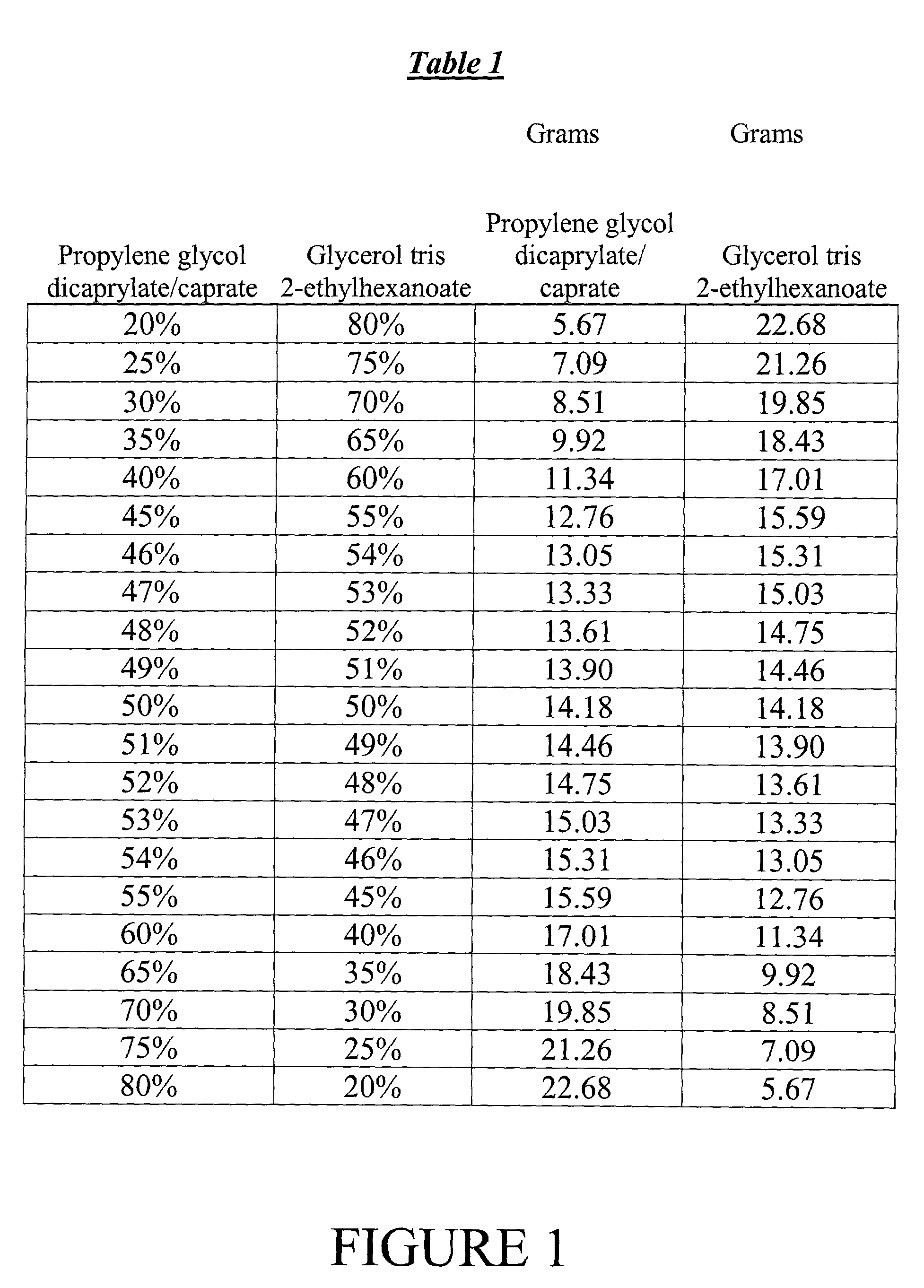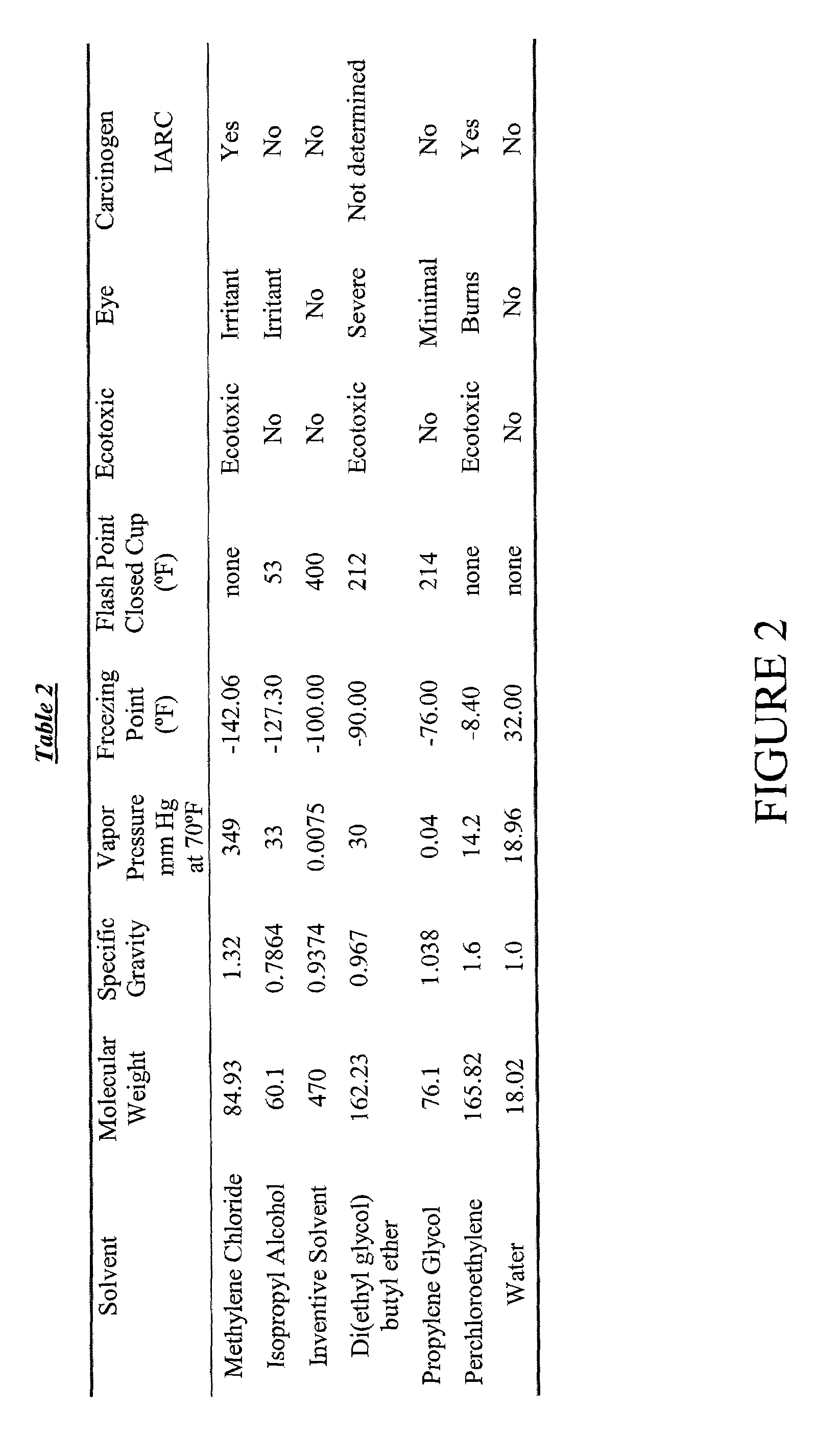Non-lethal temporary incapacitation formulation and novel solvent system
- Summary
- Abstract
- Description
- Claims
- Application Information
AI Technical Summary
Benefits of technology
Problems solved by technology
Method used
Image
Examples
example 1
[0060]Propylene glycol dicaprylate / caprate in the weight in grams noted in Table 1 below was mixed with glycerol tris 2-ethylhexanoate in the weight in grams noted to yield a solvent system having a viscosity of 33 centipoise and a specific gravity of 0.9374. The components were each measured and then placed in a one ounce or 28.35 gram net weight container and mixed together with minor agitation. The results are set forth in Table 1 of FIG. 1.
[0061]The solvent system was compared to other known solvents as set forth in Table 2 in FIG. 2.
example 2
[0062]The procedures of Example 1 were followed with the additional step of introduction of a propellant via pressure in the canister in aliquots with shaking prior to introduction of the next aliquot until the indicated amount of propellant was introduced into the solvent system. The amounts and results are set forth in Table 3 below.
[0063]
TABLE 3Propylene glycolGlycerol trisCO2 orPropellantdicaprylate / caprate2-ethylhexanoateOther PropellantsGrams18%78%4%1.1323%73%4%1.1328%68%4%1.1333%63%4%1.1338%58%4%1.1343%53%4%1.1344%52%4%1.1345%51%4%1.1346%50%4%1.1347%49%4%1.1348%48%4%1.1349%47%4%1.1350%46%4%1.1351%45%4%1.1352%44%4%1.1353%43%4%1.1358%38%4%1.1363%33%4%1.1368%28%4%1.1373%23%4%1.1378%18%4%1.13
example 3
Active Ingredient / Solvent System
[0064]The procedures of Example 1 were followed with the additional step of introduction of an active ingredient (capsaicin) into the container prior to the minor agitation step. The amounts and results are set forth in Table 4 below.
[0065]
TABLE 4Propylene glycolGlycerol trisdicaprylate / caprate2-ethylhexanoateActive Ingredients19.28%79.28%1.45%24.28%74.28%1.45%29.28%69.28%1.45%34.28%64.28%1.45%39.28%59.28%1.45%44.28%54.28%1.45%45.28%53.28%1.45%46.28%52.28%1.45%47.28%51.28%1.45%48.28%50.28%1.45%49.28%49.28%1.45%50.28%48.28%1.45%51.28%47.28%1.45%52.28%46.28%1.45%53.28%45.28%1.45%54.28%44.28%1.45%59.28%39.28%1.45%64.28%34.28%1.45%69.28%29.28%1.45%74.28%24.28%1.45%79.28%19.28%1.45%
PUM
| Property | Measurement | Unit |
|---|---|---|
| Fraction | aaaaa | aaaaa |
| Fraction | aaaaa | aaaaa |
| Fraction | aaaaa | aaaaa |
Abstract
Description
Claims
Application Information
 Login to View More
Login to View More - R&D
- Intellectual Property
- Life Sciences
- Materials
- Tech Scout
- Unparalleled Data Quality
- Higher Quality Content
- 60% Fewer Hallucinations
Browse by: Latest US Patents, China's latest patents, Technical Efficacy Thesaurus, Application Domain, Technology Topic, Popular Technical Reports.
© 2025 PatSnap. All rights reserved.Legal|Privacy policy|Modern Slavery Act Transparency Statement|Sitemap|About US| Contact US: help@patsnap.com



